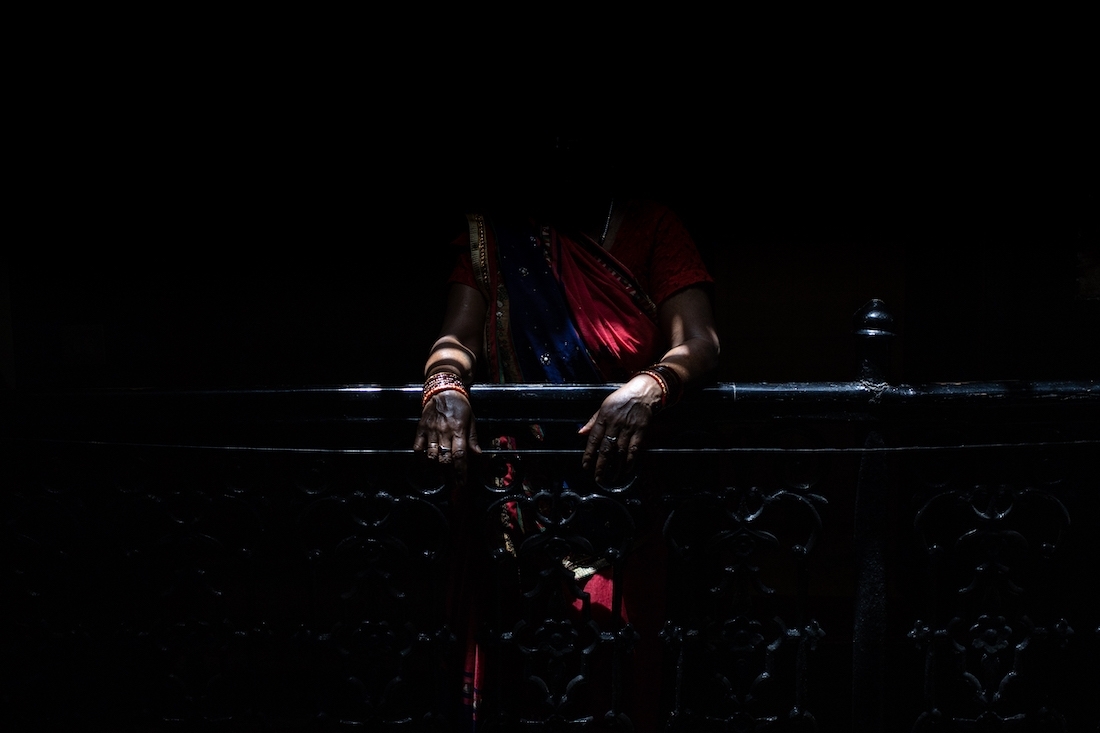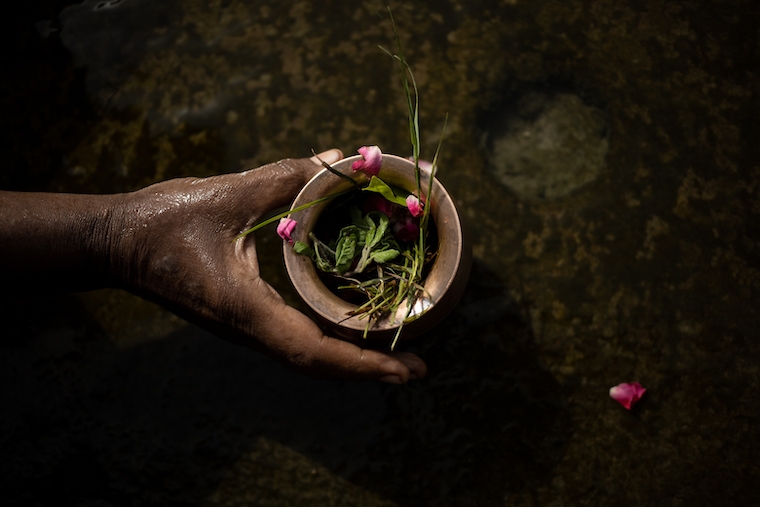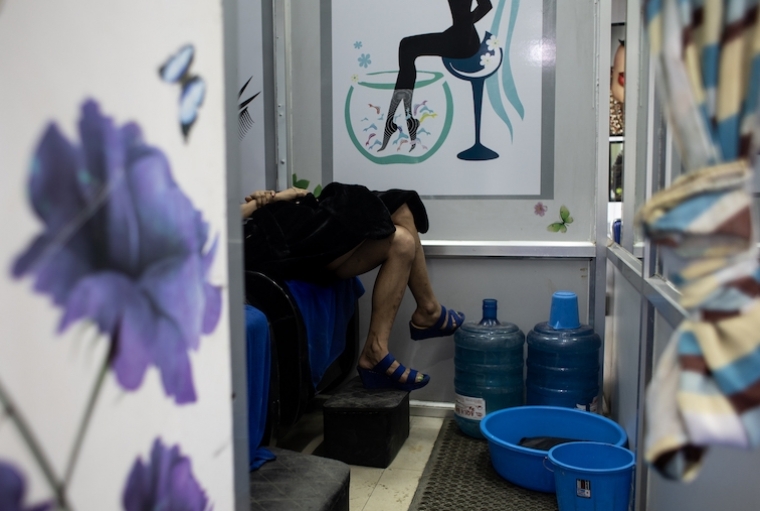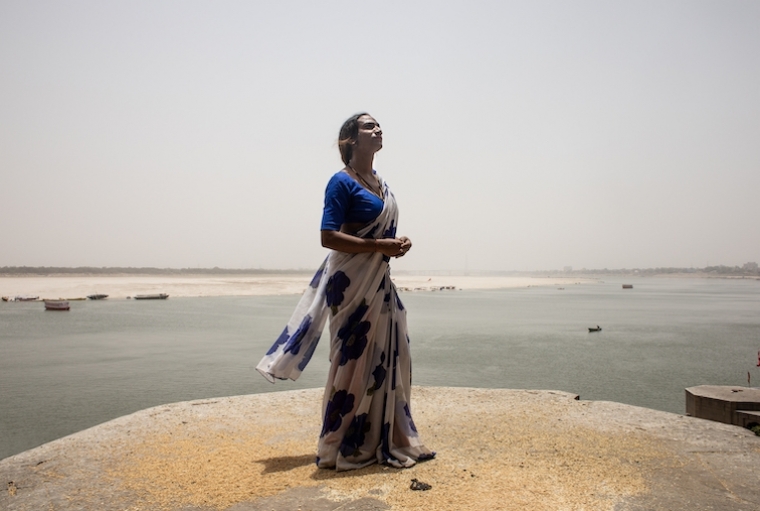
Hindu woman poses for portrait in a residence in Varanasi, India

Hindu woman poses for portrait in a residence in Varanasi, India
Brazil-based documentary photographer, Daniela Agostini’s lens primarily focuses on gender issues. Her primary intention as a photographer has been to travel to various places, delve into the unique cultures and explore the complicated relationship between the cultures and the marginalised gender communities. These concerns led her to India and the Hijra community, a community of transgender people that play a significant part in the country’s cultural practices. For instance, one particular shot from her work in India is a portrait of a transwoman named Rupaa, juxtaposed against the backdrop of the river Ganges, a rather important river pertaining to Hinduism, thus eliciting the important connection between the community and the religion.
We connected with Daniela to know more about her practice and her experiences in India.
How you were led towards photography?
Photography came about in my life by chance. Since I was very young, I was interested in the diversity that existed in different realities. I loved listening to others, understanding and experiencing the world through it. Sensitivity has always been a very vivid characteristic within me, since I was young I liked cinema and literature, at that time the photographic field was unknown to me until a friend told me a little about the work of some photographers and my curiosity for this practice was aroused. I started studying analog photography in the city where I was born, in the south of Brazil, and my interest in deepening my knowledge in the area was consolidated in an authorial photography course, through which I understood that I could use photography as a tool of expression and use it to tell other people's stories. Since then, I have not stopped photographing. I started this incessant search for the other and I continue to this day.
What informs and inspires your practice as a photographer?
‘I tend to think of the act of photographing, generally speaking, as an adventure. My favorite thing is to go where I’ve never been.’I chose this quote made by photographer Diane Arbus to talk about what inspires my photographic practice. Diane Arbus was one of the references I met when I started shooting, and her work was a discovery about where photography could take me. It was inspiring to know the work of a woman, who in the 1960s, gave up a life shaped by American social standards to live on the margins of the society, through the stories of the characters she chose. Nowadays I keep looking for inspiration from artists like her, producing works that present and discuss social issues related to gender. I like to follow women who work in a medium which over time has become very masculinized, like documentarism. It bothers me, the challenges that women encounter in documentary photography in relation to their security, and the limitation of opportunities, so names that choose to persist with these difficulties are also very inspiring for me.

Muskan throws flowers at the Ganges river
If you could, how would you define your artistic sensibility?
My sensitivity is born through the stories, through the urgency to be shown and discussed. My sensitivity is born through empathising with others. Issues related to women, some time ago, became the centre of my work, and I decided to address these issues outside the context I live in, through other cultures. I started researching and traveling to places in the Middle East, Asia, and Brazil. I developed a work that talked about the use of Hijab in Iran, I learned a little about the history of Hindu women in Nepal, and I worked with a photographer friend, developing a documentary about women funk singers in Brazil (Brazilian culture and musical style from peripheries). A little over a year ago, for personal and identity reasons, I decided that I needed to talk about other gender issues, still relating to the culture of these places, and I am still working on this topic today.
What drew you towards India and how did you explore it through your work?
Since I started researching about Asian places and their cultures, I was motivated to get to know India. Hinduism was already a religion that aroused my commotion and curiosity since my trip to Nepal in 2014, but I decided that I would only go to India when I found something that made a lot of sense for my work. In 2018 I started researching the LGBTQIA + movement in some places in the world that I was interested in, and found some stories about the relationship between Hinduism and transsexual women, known as Hijras, in India. Diving into these stories through documentaries and some publications that I found on the subject was very inspiring, so I decided to focus on that subject and travel to India the following year. I managed to get the job done, I fell in love with the places I went to during the trip, I enjoyed the local cuisine which is now one of my favorites, I tried to experience the culture through the people I met, I even fell in love with the kindness and warmth of the Indian people. I have no doubt that this is a project that needs more time to be completed, I intend to return and be able to follow the characters with whom I worked for longer.

Meghna in a beauty salon, Kathmandu, Nepal
Could you take me behind your creative process as a photographer, especially vis a vis your work in India?
Usually my process starts with research on the subject that I am proposing to work on. Within this research I also seek to enhance my visual identity through artistic references from cinema, literature and photography. I find it incredible, at this point in the process, when I can find in these languages ​​the subject I want to address or the place where I intend to work. It expands my imagination and with that the work begins to take shape before it even happens in practice, so it is very motivating. At the same time, I start to look for people, contacts who can make the development of work more flexible — this part is crucial especially if my time on site is not extensive, as was the case in India.
When I am photographing, my process is like an intense dive into the experience with the others and with the place, from there the photography happens naturally. Finally comes the work of constructing the narrative, usually it is a moment after the experience, a time to look at the material, relive that story in order to find a result that better speaks of the lived experience, along with the information found during the journey. I usually work on editing while everything is still very much alive. I like to create a favorable environment, which takes me to that place with the intensity that I experienced, but now in the form of memory. I brought a lot of incense from India and got to know a little about the local music — while editing the work I used these artifacts to create this sense of belonging.
What kind of challenges did you face during your work in India?
My biggest challenge in India was finding my characters. In documentary photography, I always see this moment in the process as the most difficult. As I mentioned in the previous answer, I usually try to find people who facilitate this contact with possible characters, before starting work. In the case of India, I couldn't find anyone. Right at the beginning of the research, I talked to a girl who is an LGBTQIA+ rights activist and lives in Bangalore, but my intention was to work in Varanasi. We were able to just exchange information only on the movement in India, as a whole.
The days I was in Varanasi, I tried to meet some characters by chance, which I like to do in my work too, as a way to let the work itself find its narrative, but the days went by and nothing happened. I decided to ask the people I was getting to know, which was very difficult because most of them did not feel comfortable talking about the subject, let alone saying that they knew someone from the community. With only a few days to go back to Delhi and on my way back to Brazil, my relationship with a young man, called Moon, who lived near the place where I was staying and used to talk to me ever since the beginning of my trip to Varanasi, narrowed. We spent some afternoons talking on the banks of the Ganges River about the peculiarities of Brazil and India. Already without much hope of meeting my characters, I told Moon the purpose of my travel through Varanasi, and he coincidentally, knew a place where a community of Hijras lived, and created this bridge between me and them. I exchanged messages and phone calls with Rupaa, and two days later we had our first meeting. Unfortunately, I met Rupaa in the last few days of the trip.

Rupa poses for portrait in front of the Ganges river in Varanasi, India.
What do you hope people take away when they view your work?
Every time I'm working on a project, my goal is to use photography as a tool for discussion, denunciation, and reflection. The idea is to be able to sensitize people who come to my work in relation to the subject I am addressing.
How have you been coping with the pandemic and what will be the new normal for you post it?
Dealing with the pandemic has been a major challenge. Social distance, seclusion and fear related to the existing threat, and the uncertainties of the future are everyday situations and sensations now. I can't say what the future holds, and I also don't know exactly what the practical significance of this new normal will be, but I try to focus on the now, researching what is being produced in Brazil and in the world, trying to take advantage of the opportunities that are appearing within this scenario, and mainly using this time to think about my process as a human being and photographer. There are undoubtedly many challenges for my area, I work together with others, and social distance makes it difficult to accomplish things that were previously possible in this regard. I've been looking for new ways to continue this with the tools available now.
Lastly, what are you working on next?
I am currently in a process for understanding the ways of building a project that addresses how transgender people are being affected by the pandemic in Brazil, specifically in São Paulo, the city where I live. The vulnerability existing in these bodies is already a reality in which these people are, and without a doubt these issues are being enhanced by the pandemic. Difficulties in the job market, lack of health-care and increase in domestic violence are points that I want to address in this work. I've been trying to follow the story of some women who live in a foster home called Casa Florescer, and I intend to develop a photographic work, remotely, where in addition to images made by me, they can also photograph their routines, being protagonists of this project, through online photography workshops. The work is still in process, and the great difficulty is to be able to establish these relationships at a distance. I hope I can find a safe way for work to happen. Cheering for this! Meanwhile, the intention to continue my work in places like India, has been postponed until the moment when we can be together again.
Text Nidhi Verma